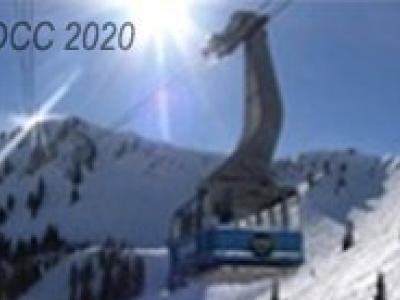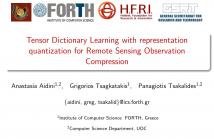
The Data Compression Conference (DCC) is an international forum for current work on data compression and related applications. Both theoretical and experimental work are of interest. Visit website.

- Categories:
 67 Views
67 Views
- Read more about Improved Hard Decision Quantization with Decision Tree for HEVC Video Compression
- Log in to post comments
In this paper, we design an improved hard-decision quantization (HDQ) scheme for HEVC compression. A decision tree model is generated based on the behavior of the soft-decision quantization (SDQ) in HEVC, and it is utilized to help making decision for each quantized level in the proposed HDQ. Experimental results show that our proposed quantization scheme achieves an average of 3.11% coding gain compared to the conventional HDQ and it provides a more hardware friendly implementation than SDQ.
- Categories:
 51 Views
51 Views
- Read more about Secondary Intra Prediction Scheme for HEVC
- Log in to post comments
Conventional intra prediction usually utilizes the top and left reconstructed reference samples of the current block to generate prediction pixels. However, with the distance between reference samples and the predicting pixel increasing, the correlation of them becomes weaker. The loss of the bottom-right corner of the current block is bigger than that of the top-left corner. To improve the situation above mentioned, a novel secondary intra prediction scheme is proposed for video coding in this paper.
- Categories:
 28 Views
28 Views
- Read more about Advanced Geometric-Based Inter Prediction for Versatile Video Coding
- Log in to post comments
Block-based partitioning is one of the fundamental techniques in video coding. Geometric-based block partitioning is a well-studied method to enable better spatial adaptation to the signal properties. This paper introduces the most recent proposal of advanced geometric-based inter prediction (GIP) made to the state-of-the-art are video coding standard - Versatile Video Coding (VVC).
- Categories:
 121 Views
121 Views
- Read more about Tensor Dictionary Learning with representation quantization for Remote Sensing Observation Compression
- Log in to post comments
Nowadays, multidimensional data structures, known as tensors, are widely used in many applications like earth observation from remote sensing image sequences. However, the increasing spatial, spectral and temporal resolution of the acquired images, introduces considerable challenges in terms of data storage and transfer, making critical the necessity of an efficient compression system for high dimensional data. In this paper, we propose a tensor-based compression algorithm that retains the structure of the data and achieves a high compression ratio.
dcc_aidini.pdf
- Categories:
 44 Views
44 Views
- Read more about Sub-Sampled Cross-Component Prediction for Chroma Component Coding
- Log in to post comments
Cross-component prediction, which takes advantage of inter-channel correlations, predicts the chroma block with the luma reconstructed block according to the associated linear model. Instead of involving all available reference samples in building the linear model, in this paper, we propose a sub-sampled approach that utilizes at most four neighboring chroma samples and their corresponding down-sampled luma samples, leading to significantly reduced operations in the derivation of model parameters at both encoder and decoder.
- Categories:
 151 Views
151 Views
- Read more about Revisiting Local Texture Correlation for Rate-Distortion Optimized Intra Coding
- Log in to post comments
In this paper, we focus on computationally modeling of the local texture correlations, in an effort to better explore the coding modes with higher priorities in the rate-distortion optimized intra coding. In particular, strong correlations and continuities of local texture with neighboring blocks have been revealed in our analysis, and empirical justifications provide us inspirations on the joint optimization of rate-distortion-complexity when angular modes become finer to adapt the local textures.
- Categories:
 59 Views
59 Views
- Read more about Higher-order Count Sketch: Dimensionality Reduction That Retains Efficient Tensor Operations
- Log in to post comments
- Categories:
 29 Views
29 Views
- Read more about Fast CU Size Decision Using Machine Learning for Depth Map Coding in 3D-HEVC
- Log in to post comments
3D-High Efficiency Video Coding (3D-HEVC) is a video compression standard developed for multi-view video plus depth map coding based on the latest HEVC coding standard. We propose an eXtreme Gradient Boosting (XGBoost) system based fast coding unit (CU) level decision for depth maps, which is used to solve the problem of high coding complexity caused by the addition of depth maps and new coding tools in 3D-HEVC. We explore the application of data mining and machine learning in video coding by using texture feature attributes that are highly correlated with CU size.
- Categories:
 27 Views
27 Views